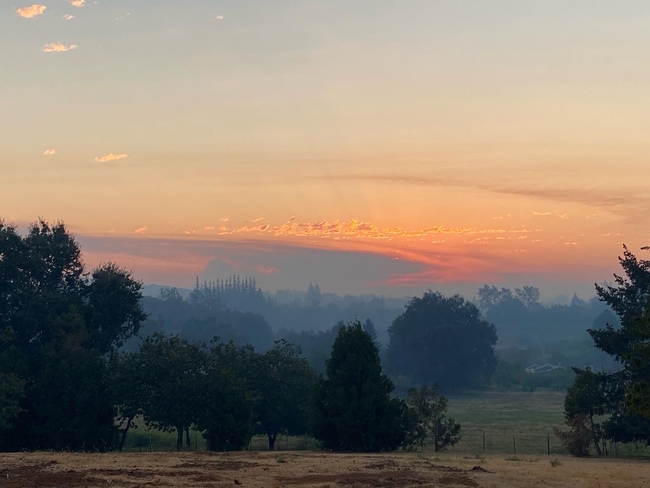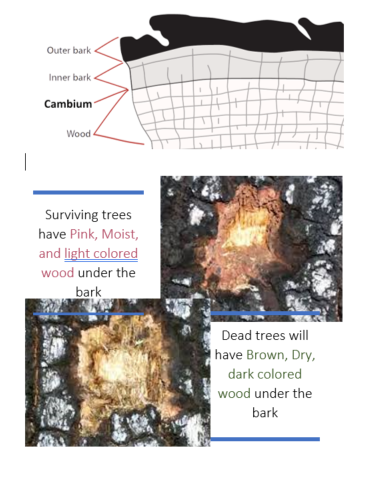
Along with damage to built structures, vegetation and natural areas on the property may need restoration – dry forage conserved for fall grazing must be replaced (likely with purchased hay in the short-term), drainage around damaged culverts and road surfaces must be mitigated before the winter. Other impacts may also emerge in the coming months – some trees that were scorched will survive while others die; burned brush may vigorously resprout and develop into future fire hazards; invasive weeds may gain a foothold on bare ground.
To help landowners and managers assess the conditions of their properties and make decisions about managing their resources going forward, we've compiled a number of helpful resources below:
Evaluating burn severity
The most damaging long-term impact to natural resources after wildfire is soil erosion. Loss of aboveground cover and even surface cover exposes soil to erosive effects of precipitation and runoff. This may be worsened on steep slopes or areas where roads are damaged and water may channelize. There are many different methods land owners can use to reduce the risk of significant soil erosion post-fire. Generally, the faster you implement erosion mitigation techniques, the more you increase the likelihood of reducing erosion impacts. You can find more information about erosion mitigation on the UCANR Fire website.
Consider evaluating risks to soil on and leading to your property. On private land, consultation with the Natural Resource Conservation Service, local RCD, or private land restoration consultant may help determine the severity of damage and what restoration work is needed to protect the soil.
If adjacent to federal land, Burned Area Emergency Response (BAER) teams are currently assessing severity impacts to determine where protection measures are required to minimize damage to soil productivity, hydrologic function, and water quality. Once complete, these reports will be made public and can be used to identify potential risks to your property.
El Dorado County NRCS: Brook Fuller (530) 295-0120 ext 3
Placer County NRCS: Chris Robbins (530) 217-6258
Tree mortality
Not all trees will die after being damaged by fire. Native California tree species have several adaptations which can help them survive or recover quickly after fire. If a tree does not pose an immediate hazard to health or property, it may be worth waiting to see whether it will recover.
Hardwoods and conifers differ in their resistance and ability to recover from fire. Since conifers only produce one set of foliage each year, the loss of foliage can be fatal. Typically, conifers may survive with as little as 25% of the crown remaining intact. However, smaller trees (less than 6 inches in diameter) and where the entire base of the tree has been exposed to fire, are unlikely to survive.
In contrast, oaks can potentially re-leaf after and therefore survive when all the foliage has burned off. Even when the trunk has been killed, many oaks will resprout from the roots in the spring, which can re-establish more quickly than acorn plantings.
If uncertain, cut small openings in the bark to expose the cambium layer underneath and check if the cambium is moist. A slow burning fire may leave the foliage green, but kill the live cambium tissue of the tree.
It is also important to consider the difficulty and cost associated with removing a tree now versus in the future. Depending on the size of your property and the number of trees, emergency exemptions may be available to remove any damaged trees and accelerate the regeneration of a forest stand. Consult with a local Registered Professional Forester or Certified Arborist for more information.
For more information, see Post Fire Recovery for Forest Landowners (UCCE).
Smoke/ash impacts on forage and livestock health
While wildfire may directly injure livestock, we're often more concerned with short and long-term impacts from smoke inhalation. To reduce stress and health risk to your livestock, limit exercise when smoke is visible. Particulates can also alter the immune system and reduce the ability of the lungs to remove foreign materials, such as pollen and bacteria, to which livestock are normally exposed. If livestock have experienced coughing over a long period of time, there is a greater risk of secondary problems such as bacterial pneumonia. Give livestock ample time to recover from smoke-induced airway insult.
Plan on giving livestock 4 to 6 weeks to recuperate after the air quality returns to normal. Handling, moving, or transporting livestock during this time may aggravate the condition, delay the healing
process, and compromise the performance of livestock for many weeks or months. If your livestock continue to experience primary or secondary problems with smoke-induced respiratory injury, you should contact a livestock veterinarian.
Forage toxicity is also a common concern after a wildfire, particularly in areas where structures and household products have been lost. Forage sampling research conducted after previous fires has demonstrated little evidence of wildfire ash causing increased heavy metal or other toxicity issues in forages. While more detailed studies are needed to provide additional information, preliminary results from recent fires with a high degree of structure loss have shown that forages affected by wildfire ash deposition are likely safe for livestock to consume. If you have forages that may be affected by ash deposition, evaluate the concentrations of minerals before formulating a ration. If you're exceptionally concerned about toxicity from contamination and cannot dilute with unaffected feed, isolate and test feed for heavy metals and organic compounds. Reach out to your local UCCE Farm Advisor if you have questions regarding taking a representative sample, choosing a lab, lab analyses, or interpreting your results.
Livestock Damage: Wildfires, Smoke, and Livestock (UC Davis)
Forage Toxicity: Wildfire Ash: Impact on Forage Crops
Contact the Farm Service Agency for more information about livestock disaster programs.
Rangeland seeding
Preventing soil erosion is a top priority for fire-impacted rangelands. Physical changes to the soil, combined with loss of vegetation, can create a variety of problems including soil movement, increased runoff, mudflows, and debris flows. Research indicates that the amount of exposed mineral soil, regardless of slope, is correlated to erosion potential. For rangeland livestock operations, weed-free straw mulch is the best option for keeping soil in place. Soil protection measures should be in place before the first significant rain of the autumn.
For more information, see After the Fire: Resources for Ranchers.
Infrastructure recovery
Do not re-enter any areas that were heavily damaged or destroyed by fire until local fire authorities have cleared the area. Once you re-enter, it is important to assess hazards to protect your health and safety. Personal Protective Equipment such as N95 rated masks, protective clothing, gloves, and boots, and eye protection can reduce exposure to hazards.
There are a number of risks to be aware of when returning to your home post-fire.
- Check for the smell of gas. Turn off power until you've completed your inspection. Use a battery-powered flashlight to inspect a damaged home. (Note: the flashlight should be turned on outside before entering. The battery may produce a spark that could ignite leaking gas, if present.)
- Do not drink or use water from the faucet until emergency officials say it is okay; water supply systems can be damaged and become polluted during wildfires or as a result of subsequent post-fire flooding. If your well has been damaged by fire, contact a local licensed and bonded well constructor or pump installer to determine the extent of the damage and what must be done to either repair or decommission the well.
- Discard any food that has been exposed to heat, smoke, flood waters, or soot, as well as food that may have spoiled while your home was without power.
- Check to make sure the main breaker is on. If the breakers are on and power is still not present, contact the utility company. If you have a propane tank or system, contact a propane supplier, turn off valves on the system, and leave valves closed until the supplier inspects your system. If you have a heating oil tank system, contact a heating oil supplier for an inspection of your system before you use it. If you have a solar electrical system, this system should be inspected by a licensed technician to verify that the solar panels and electrical wiring are safe for continued operation.
Before cleaning up post-fire, create a list of damaged belongings. Photographing may help you document damages when working with you insurance provider. FEMA post-fire fact sheet
Next, you should decide how you want to remove debris. There are three main options for doing so 1) government-run programs 2) private contractors and 3) doing it yourself.
- Generally, counties implement a multi-phase approach to remove hazardous materials from residences: Phase I: removing household hazardous waste that may pose a threat to human health (e.g., batteries, asbestos siding, paints).
- This is required for all residential properties, but will be a free service in both counties. .
- Phase II: removal of debris and conducts property clean-up work. This includes removal of all burnt debris, foundations, hazardous trees, and contaminated soil to ensure the site is safe for building. Participation in the government run debris removal program is encouraged but optional.
- Information about Phase 2 in El Dorado and Placer Counties will be released in the coming weeks.
Food Safety: Food Safety Following Wildfire Evacuation (UCCE)
Placer County: https://www.placer.ca.gov/mosquito-fire-recovery
El Dorado County: https://www.edcgov.us/wildfire/Pages/Mosquito-Fire-Recovery.aspx
For damages to ranch infrastructure and livestock, contact local FSA/NRCS professionals, or your local resource conservation district.
And we want to hear from you, too! What kinds of assistance and information needs do you have after the fire? We're planning on field days and workshops focused on post-fire resilience in the coming months, and want to make sure we're addressing specific questions! If you were impacted by the Mosquito Fire, please take this brief survey!
